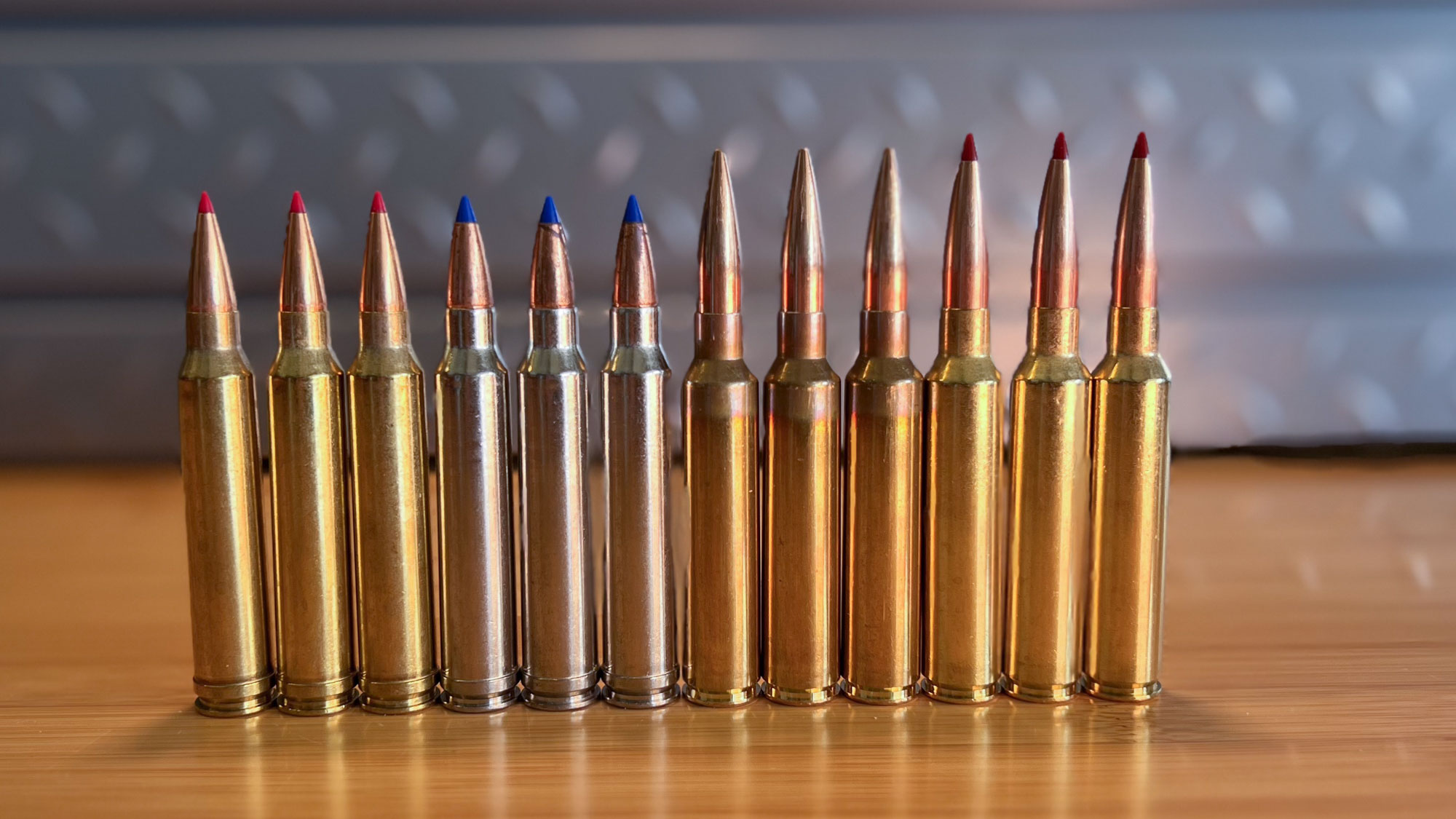We may earn revenue from the products available on this page and participate in affiliate programs. Learn More ›
If you want to ignite a spirited conversation, ask hunters and shooters for their take on the 300 PRC vs 300 Win Mag. You will quickly encounter opinions harder than granite bedrock and as difficult to navigate and unpack. Level-headed analysis is in short supply when evaluating the merits and drawbacks of these .30-caliber magnums.
Never mind which is “better” — this isn’t a clickbait article, and such a conclusion would be foolish. Both are excellent, neither is perfect, and depending on what you’re aiming for, either or both could be the right answer.
We’ll start with a quick overview of each cartridge, delve a bit into their interesting (and overlapping) histories, and then talk about their practical performance in the field, both on game and in long-range shooting applications.
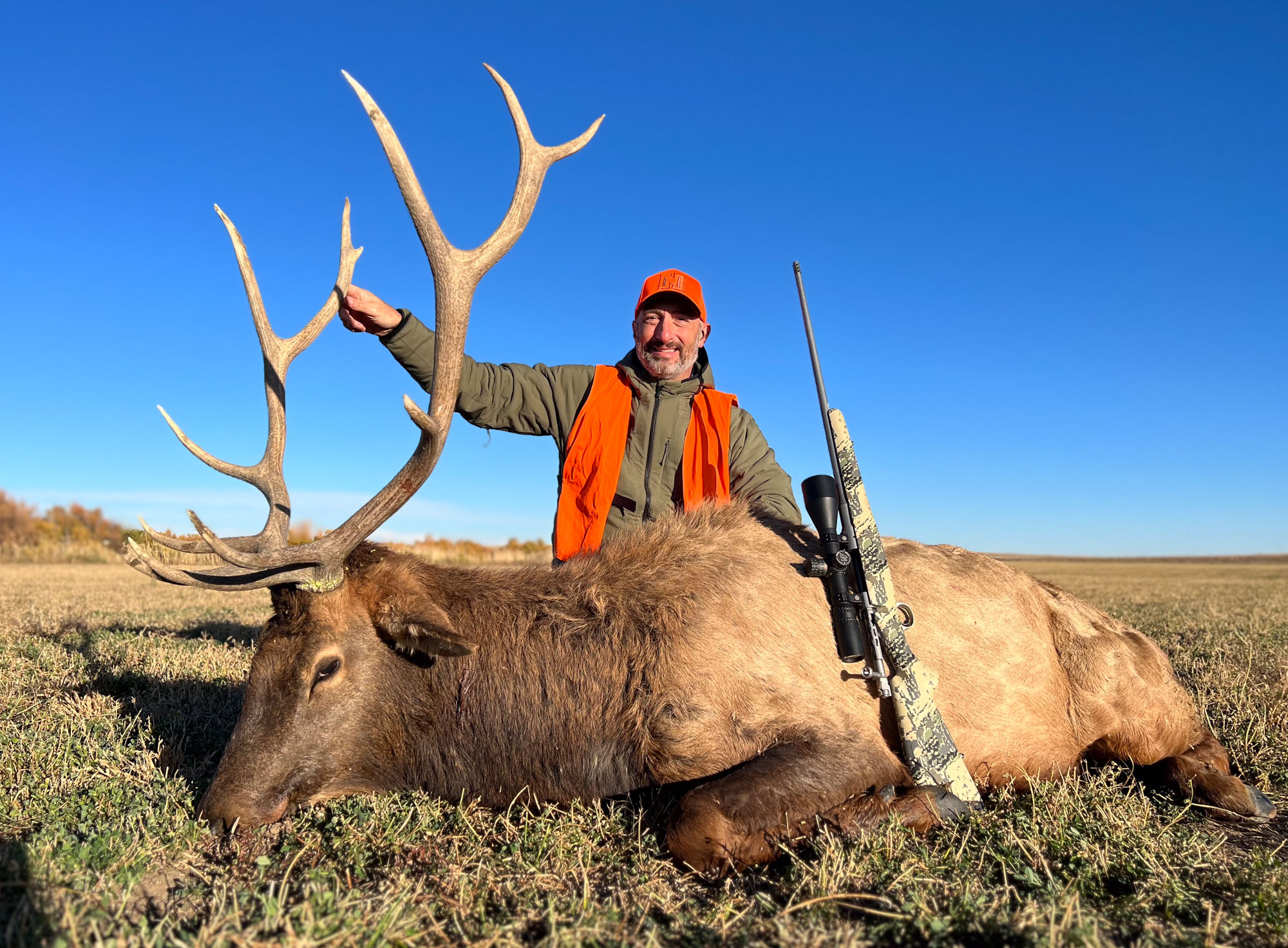
John B. Snow
300 Win Mag Specs
- Bullet Diameter: .308 inches
- Overall Length: 3.340 inches
- Case Length: 2.620 inches (standard long action)
- Case Head: .532 inches (uses standard .540 in. magnum bolt face)
- Shoulder Angle: 25 degrees
- Twist: 1:10
- Leade: .3150 inches (.007 inches over bullet diameter)
- Muzzle Velocity: 2875 to 3300 fps
- Bullet Weights: 150 to 220 grains
- SAAMI Max Pressure: 64,000 psi
- Year Introduced: 1963
- Parent Case: .375 H&H Magnum
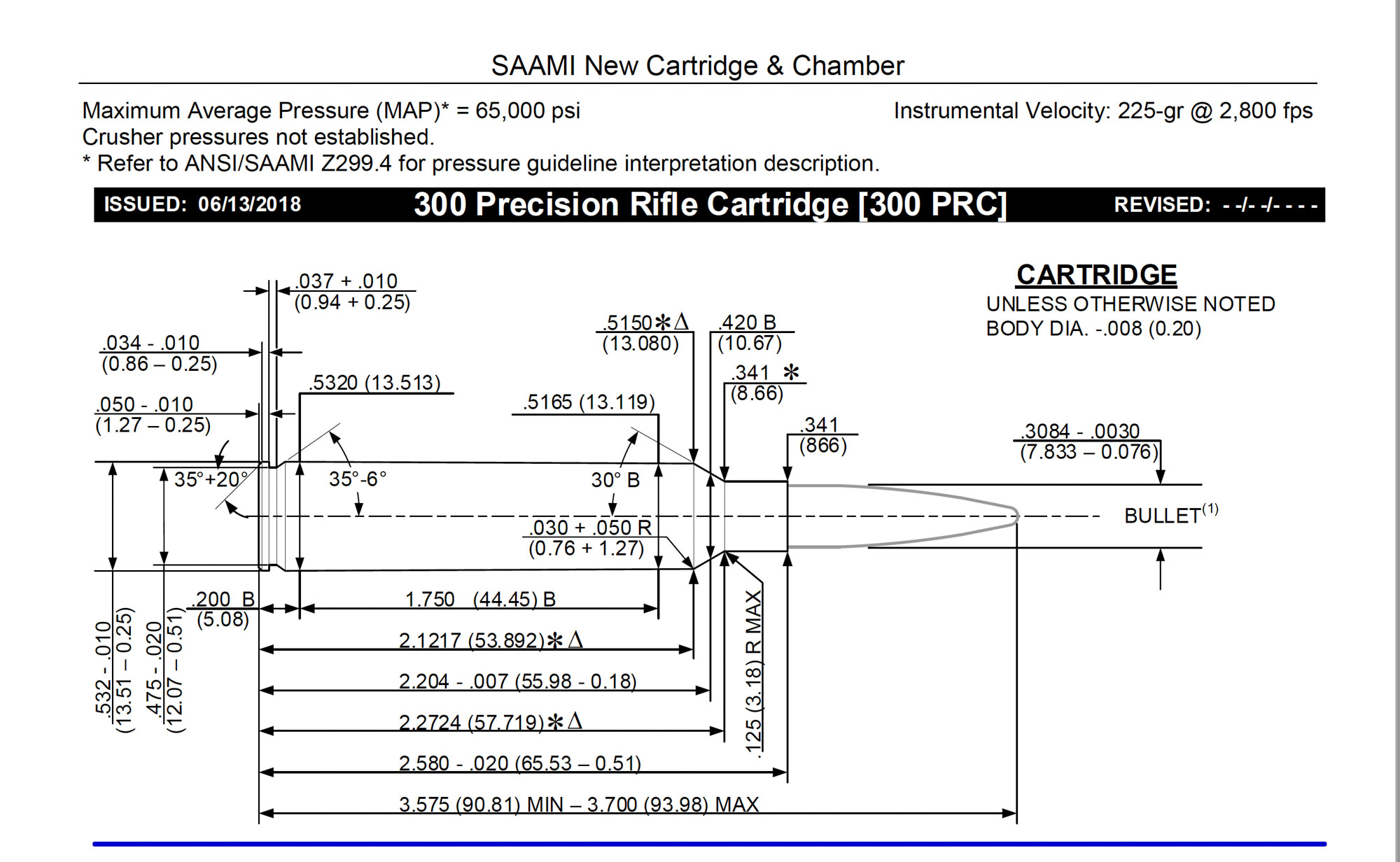
SAMMI
300 PRC Specs
- Bullet Diameter: .308 inches
- Overall Length: 3.7 inches
- Case Length: 2.580 inches (standard long action)
- Case Head: .532 inches (uses standard .540 in. magnum bolt face)
- Shoulder Angle: 30 degrees
- Twist: 1:8.5
- Leade: .3088 inches (.0008 inches over bullet diameter)
- Muzzle Velocity: 2900 to 3000 fps
- Bullet Weights: 190 to 250 grains
- SAAMI Max Pressure: 65,000 psi
- Year Introduced: 2018
- Parent Case: .375 Ruger
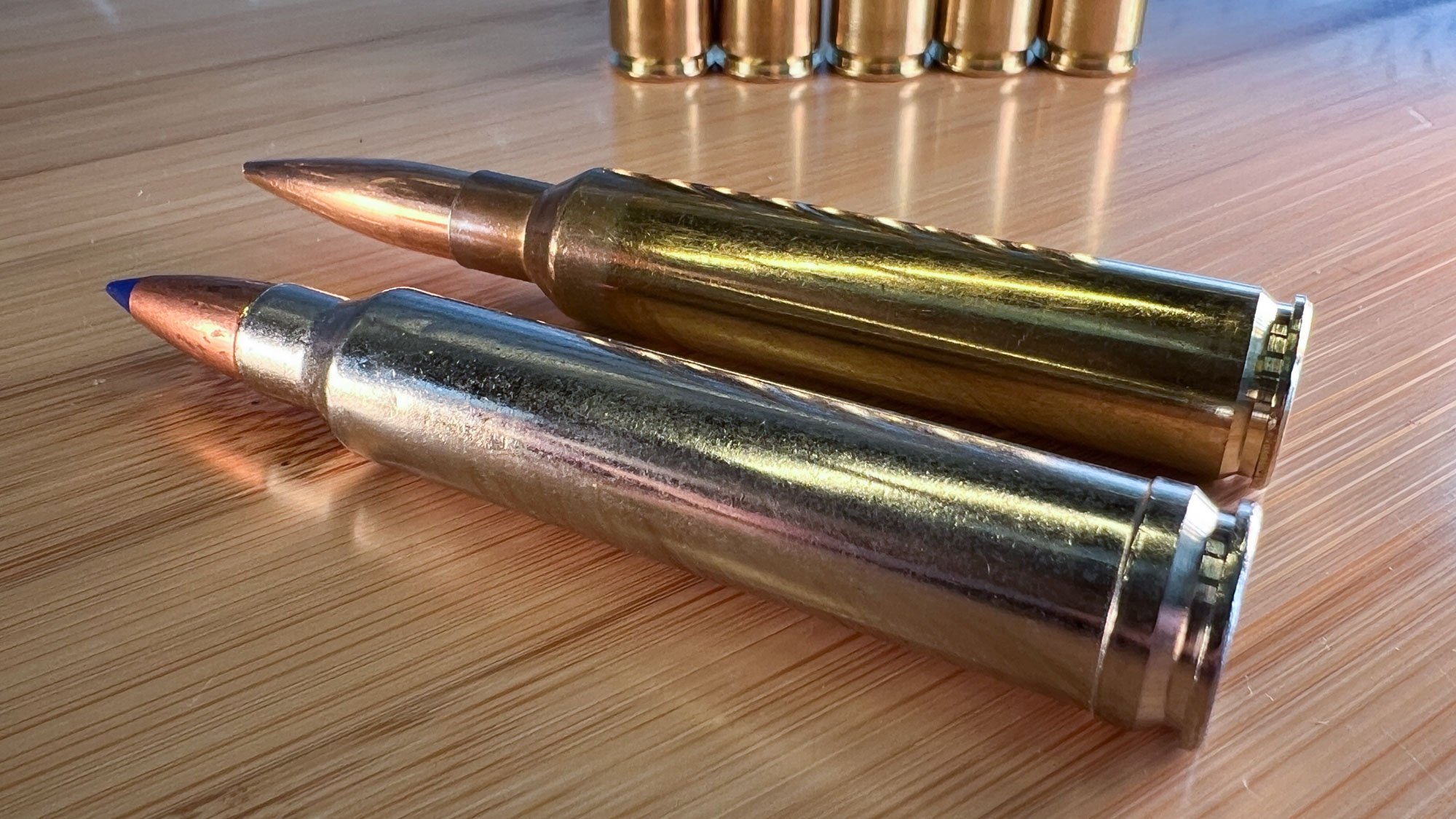
John B. Snow
300 Win Mag History
The 300 Win Mag has been America’s favorite magnum for decades now. It debuted when John F. Kennedy was president and The Beach Boys’ Surfin’ U.S.A. owned the airwaves, and it didn’t take long for Winchester’s newest belted magnum to catch on.
Like the other magnums in Winchester’s catalog— the 264 Win Mag, 338 Win Mag and 458 Win Mag were all introduced in 1958 — it was based on the immortal 375 H&H Magnum and employed the same raised belt for headspacing.
It landed in a ballistic sweet spot, offering more oomph than the .30/06 while not being as punishing to shoot as Roy Weatherby’s 300 Weatherby Magnum. It could feed from a standard-length action and was first chambered in Winchester’s Model 70.
As more sportsmen in the post-war boom were able to head West and travel internationally to hunt, they gravitated to this round when elk, moose, and bear were in the offing.
With the bullets of the time — and long before the advent of laser rangefinders—the 300 Win Mag provided a generous point-blank zero and terrific terminal ballistics that cemented its reputation among big game hunters.
The military eventually took a shine to the 300 Win Mag as well. I go into detail on its adoption as a sniper round in this story on the best long-range calibers, but it is worth noting how the cartridge managed to evolve and remain relevant even as the military developed more stringent requirements for long-range performance.
After a couple missteps in the late 1980s and early 1990s when the specific bullets used either failed to comply with the rules of war or failed to meet the military’s standards, the 300 Win Mag hit its stride.
The winning ammunition, designated A191 (Mk 248 Mod 0) used a 190-grain Sierra Matchking bullet and was considered effective to 1,200 yards, though in the field it was accurate well beyond that.
One reason for the round’s accuracy at extended distances (Navy SEAL sniper Chris Kyle used the round to kill an enemy combatant in Afghanistan at 1,600 yards) were modifications to the reamers used to chamber rifles.
As originally designed in 1963, the 300 Win Mag headspaces off the belt and has a significant amount of slop at the shoulder, neither of which is conducive to good accuracy. To overcome this design limitation, reamers were modified to tighten up the chamber, headspace the cartridge off the shoulder rather than the belt, and lengthen the throat so that heavier bullets could be used.
During the wars in Afghanistan and Iraq the military wanted a round that could be shot accurately at even greater distances, setting the threshold at 1,500 meters. Other cartridges were considered during this process, but the 300 Win Mag once again got the nod, thanks to Jeff Hoffman at Black Hills Ammunition who loaded it with 220-grain projectiles at 2800 fps.
This round produced less recoil than a 338 Lapua Magnum (which was also in the running), had downrange performance that was nearly equivalent, and was much more cost-effective.
The 300 Win Mag with this round was officially adopted in 2010 and has remained in service since.
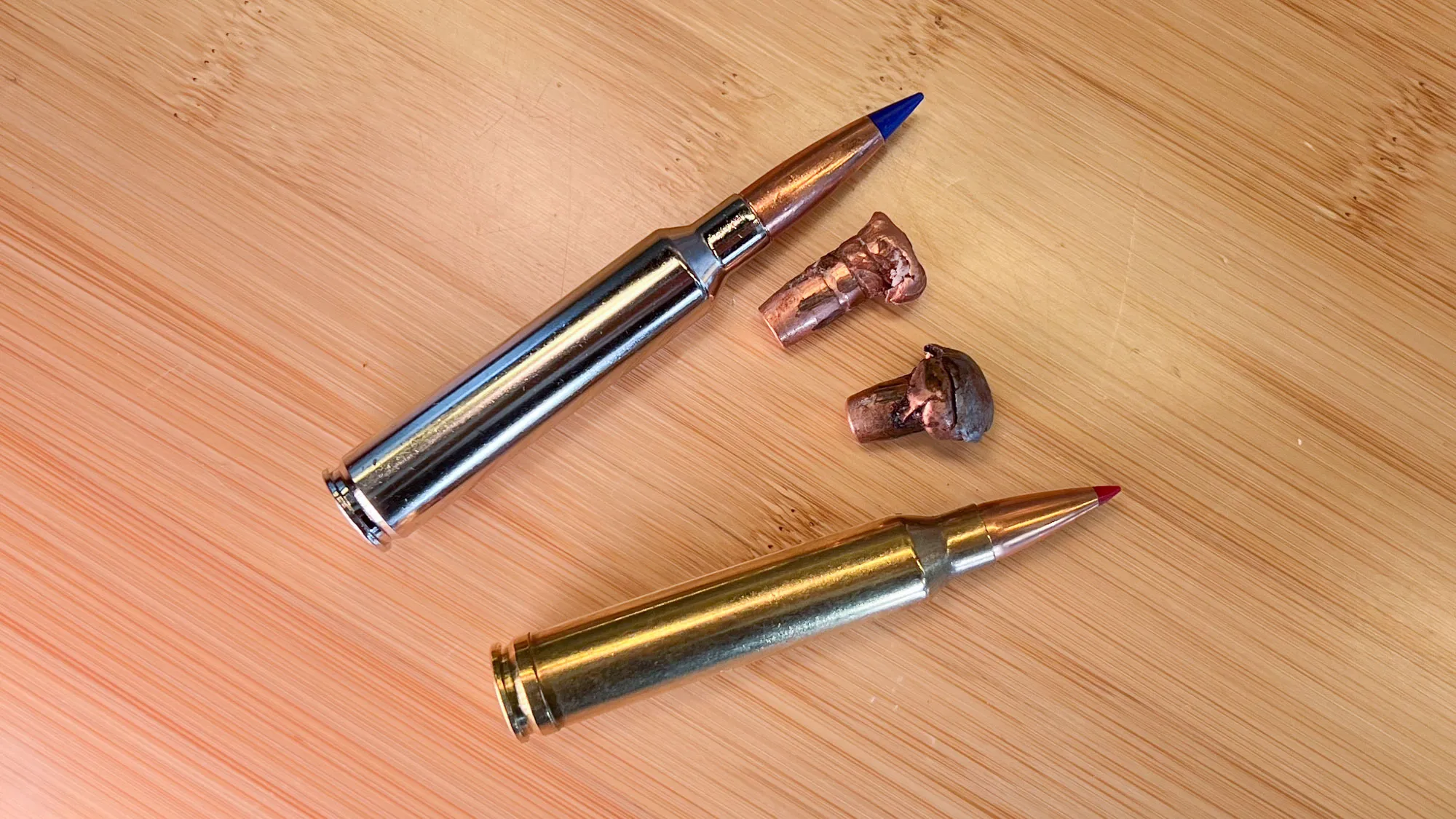
John B. Snow
300 PRC History
There are two ways to look at the history of the 300 Win Mag over the last 30 years. Either it is the ultimate survivor, repeatedly besting other potential rivals. Or the design flaws inherent to the cartridge were patched up in a band-aid like fashion to keep it slogging along, despite demonstrably better options. There’s truth to both assertions.
The 300 PRC is the most direct challenger to the 300 Win Mag’s dominance. While there are other potent .30-caliber magnums of recent vintage — the 300 Norma Magnum, 300 Remington Ultra Magnum, and 30 Nosler — from the standpoint of design and performance a strong argument can be made that the 300 PRC leads the pack.
The 300 PRC is based off the 375 Ruger — a criminally underrated cartridge in my opinion — and was originally known as the 30-375 Ruger. Joe Thielen, an engineer at Hornady, drew up the initial design and used it for 1,000-yard benchrest shooting.
I was an early adopter, too, and have a heavy-barreled bolt action from the old Montana Rifle Company (when it was still based in Montana) in 30-375 Ruger that I shot prairie dogs with at extreme distances. In fact, the first brass I had lacked any type of headstamp, and I reloaded it with dies marked “300 HSM,” which I assume stood for Hornady Super Magnum.
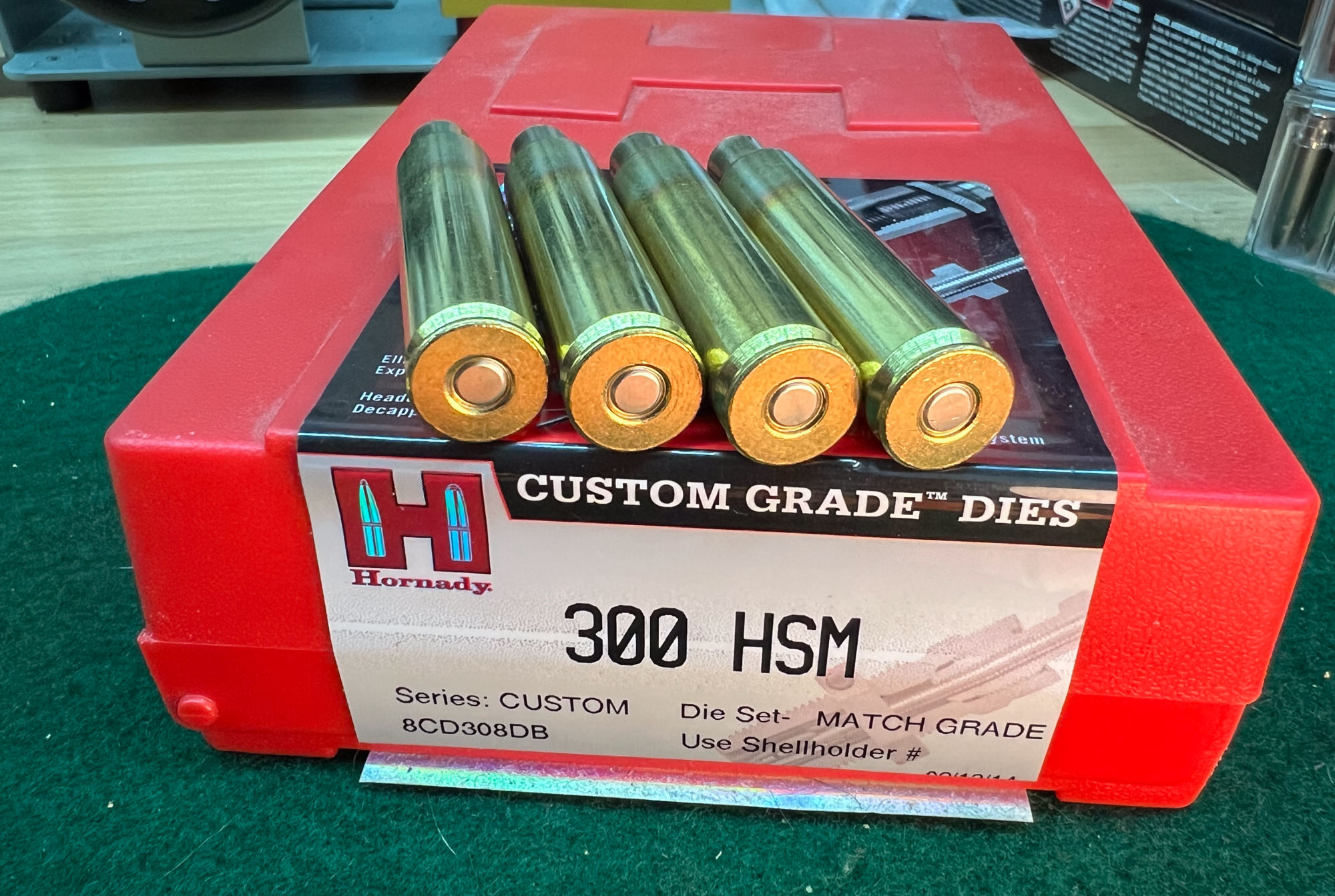
John B. Snow
The 300 PRC was officially approved by SAMMI in June 2018. One thing that prompted Hornady to commercialize the wildcat was the need for a better sniper round for the military.
In 2009, the U.S. Special Operations Command (SOCOM) turned to the gun industry to develop a multi-caliber sniper rifle system with some demanding (to the point of being unrealistic) accuracy specifications.
Hornady presented the 300 PRC as the best .30-caliber magnum, though ultimately the Army selected the 300 Norma Magnum, along with the 338 Lapua Magnum and 308 Win, for the project.
Though the Army passed on the 300 PRC, just a few years later the Navy’s Special Warfare fighters gave it the nod. They were looking for a round that had a 50 percent hit probability on a man-sized target at 2,000 yards and after testing picked the 300 PRC in favor of the 300 Norma Magnum and others.
Design Behind the 300 PRC
The 300 PRC embodies all the best practices that ballistics engineers use to get peak performance from today’s most accurate cartridges. The guidelines they employ fall under the umbrella of Modern Cartridge Design.
Broadly speaking, the goal of Modern Cartridge Design is to shoot heavy-for-caliber bullets with high BCs from cartridges and chambers with tight tolerances that promote accuracy. Features that define MCD rounds include:
- Faster twist rates to stabilize high BC match bullets
- Brass with steep shoulders and minimal case taper for greater inherent accuracy
- Chambers with tight throats barely larger than the bullet diameter
- Adequate neck length to properly support the bullets
- The ability to run long bullets without having the base of the bullet protrude into the powder chamber
Specs Comparing 300 PRC vs 300 Win Mag
This chart gives a feel for the different design philosophies behind the 300 Win Mag, which was built to drive lighter bullets as fast as possible, and the 300 PRC. It also shows the different expectations in terms of specs and tolerances.
| 300 PRC | 300 Win Mag | |
|---|---|---|
| Overall Length | 3.70 in. | 3.34 in. |
| Case Head to Neck/Shoulder | 2.272 in. | 2.620 in. |
| Twist Rate | 1:8.5 | 1:10 |
| Shoulder Angle | 30 degrees | 25 degrees |
| Headspace Location | Shoulder | Belt |
| Bullet Diameter | .308 in. | .308 in. |
| Throat Diameter | .3088 in. | .315 in. |
| Throat “Slop” | .0008 in. | .007 in. |
| Shoulder “Slop” | .006 in. | .019 in. |
One thing that jumps out when comparing the cartridges side-by-side is that even though the 300 PRC is longer than the 300 Win Mag the shoulder on the 300 PRC is positioned much closer to the case head. This is so the 300 PRC can run bullets as large as the 250-grain A-Tip in an efficient manner. When loading those long bullets (220 grains and up) in the 300 Win Mag a substantial portion of the bullet extends below the juncture of the case neck and shoulder which is not great for accuracy.
When that occurs, the bullet eats into the cartridge’s powder capacity, decreasing muzzle velocity while boosting pressure. Worse, the base of the bullet can be pushed to the side (or even bent) when the cartridge ignites, causing the bullet to enter the rifling at an angle. In the case of the 300 Win Mag the problem is exacerbated because of the amount of slop in the throat—.007 inches versus the snug .0008 inches in the 300 PRC.
In mathematical terms, the throat on the 300 PRC is 159 percent tighter than the 300 Win Mag while the allowable slop tolerance at the shoulder is 104 percent tighter.
All this is a result of the intentional design of the 300 PRC to create the ultimate .30-caliber magnum for extreme long-range shooting. The 300 Win Mag was born of another era, where the goal was to drive the typical bullets of the time (180 grains and less) as fast as possible to achieve a flat trajectory.
300 PRC vs 300 Win Mag trajectory
The data in this table is from rifles I’ve shot. With the 300 PRC, some of the data comes from my Accuracy International AXSR with a 30-inch barrel that I favor in ELR competition. Granted, that gives it an edge over the 26-inch barrels used in the 300 Win Mag data. Though there is also 26-inch barrel data for the 300 PRC, to provide some apples-to-apples numbers.
| Cartridge | Bullet | MV | Test Barrel | Drop/Drift (10 mph wind) | ||||
|---|---|---|---|---|---|---|---|---|
| 400 yards | 800 yards | 1200 yards | 1600 yards | 2000 yards | ||||
| 300 PRC | 250-gr. A-Tip | 2780 fps | 30 in. | 22 in. / 6 in. | 137 in. / 26 in. | 381 in. / 64 in. | 805 in. / 125 in. | 1483 in. / 217 in. |
| 300 PRC | 230-gr. A-Tip | 2940 fps | 30 in. | 19 in. / 6 in. | 122 in. / 26 in. | 344 in. / 64 in. | 738 in. / 127 in. | 1385 in. / 223 in. |
| 300 PRC | 225-gr. ELD-M | 3004 fps | 30 in. | 18 in. / 6 in. | 116 in. / 26 in. | 329 in. / 64 in. | 704 in. / 127 in. | 1321 in. / 223 in. |
| 300 PRC | 225-gr. ELD-M | 2840 fps. | 26 in. | 21 in. / 6 in. | 134 in. / 28 in. | 377 in. / 71 in. | 809 in. / 141 in. | 1527 in. / 248 in. |
| 300 PRC | 205-gr. Ber. EH | 2950 fps | 26 in. | 20 in. / 7 in. | 130 in. / 34 in. | 379 in. / 87 in. | 844 in. / 178 in. | 1664 in. / 321 in. |
| 300 WM | 220-gr. HPBT | 2720 fps | 26 in. | 25 in. / 9 in. | 160 in. / 40 in. | 467 in. / 102 in. | 1045 in. / 204 in. | 2028 in. / 351 in. |
| 300 WM | 190-gr. HPBT | 2900 fps | 26 in. | 22 in. / 9 in. | 147 in. / 44 in. | 448 in. / 114 in. | 1044 in. / 232 in. | 2104 in. / 399 in. |
| 300 WM | 180-gr. AccuBond | 2950 fps | 26 in. | 21 in. / 9 in. | 144 in. / 45 in. | 444 in. / 117 in. | 1049 in. / 240 in. | 2134 in. / 414 in. |
| 300 WM | 178-gr. ELD-X | 3012 fps | 26 in. | 23 in. / 9 in. | 145 in. / 41 in. | 431 in. / 108 in. | 991 in. / 219 in. | 1984 in. / 381 in. |
The point here isn’t so much how the 300 Win Mag struggles at extreme distances compared to the 300 PRC — though that is the case, and is the reason military snipers are moving away from the 300 Win Mag.
A bigger takeaway is how at 400 yards and even 800 yards, the cartridges are fairly similar, even when using radically different bullets. This means that for hunting at any reasonable distance, there’s no need to feel handicapped by the 300 Win Mag. The round’s many decades of success on big game is testament to that, but these numbers support the conclusion.
However, if hitting targets at extreme ranges is your goal, the 300 PRC outclasses the 300 Win Mag. Not only is the trajectory and wind drift more favorable, but the inherent accuracy of the 300 PRC compared to the 300 Win Mag is decisive.
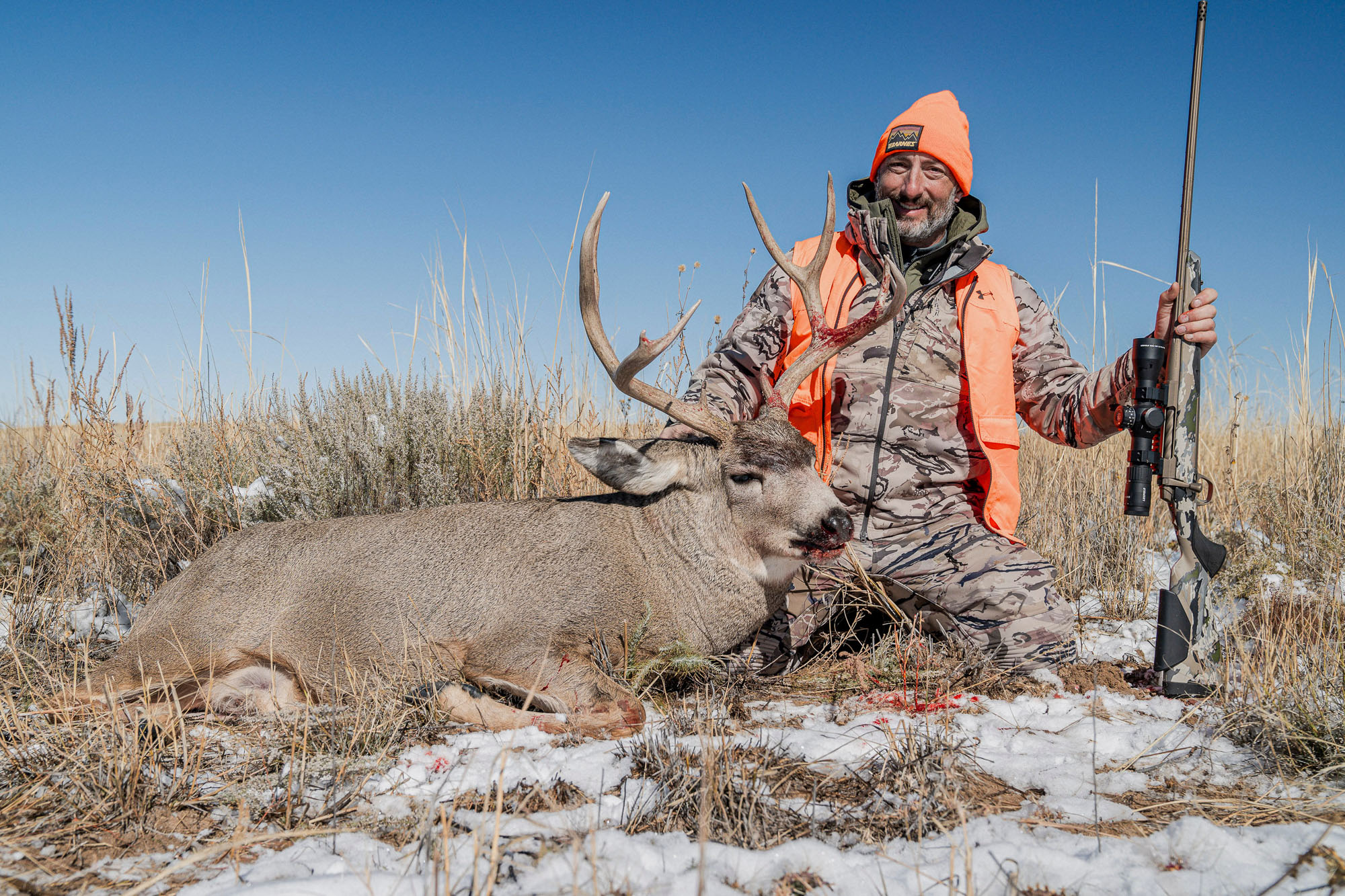
Seth Schuster / Main Beam Productions
300 PRC vs 300 Win Mag In The Field
I’ve hunted with both rounds over the years, and even took animals with one of each this last fall. I killed a 6×6 bull elk in Colorado with a 300 Win Mag shooting a 178-grain ELD-X bullet at 3012 fps. The rifle I used was quite accurate with that Hornady ammunition and a single shot at just over 600 yards downed the bull.
The ELD-X bullet performed just as designed, retaining 75 percent of its weight while forming a perfect mushroom that I recovered under the hide on the off side of the elk.
In the 300 PRC, I shot Barnes’ 208-grain LRX bullet in the new Browning X-Bolt 2. It also did its job on the mule deer I killed at 400 yards.
From the standpoint of hunting at these distances I don’t think there’s a meaningful difference between the rounds.
On the competition side, it’s a different story. I prefer to roll with the 300 PRC in ELR matches, leveraging that round for all it is worth. The Nightforce ELR Steel Challenge is one of the most demanding long-range shooting events out there, and the 300 PRC really shines under those conditions.
I delve into the weeds about my preparation for that match in this story, but the headline is that after a lot of load development I was able to craft ammunition that shot in the .5s (just over ½ MOA) with SDs around 9 to 10 fps, which served me well. That was with Hornady 230-grain A-Tips over 77.5 grains of H1000 with ADG brass and Federal 210M primers. That combo drove those bullets at 2940 fps, which was my target muzzle velocity. (It is one of the loads listed in the trajectory chart above.)
While the 300 Win Mag has been used in competition — it was a popular 1,000-yard round back in the 1960s up through 2000 — it is not a go-to round for many long-range competitors, though you will still see it on the firing line (in highly modified chambers) even today.
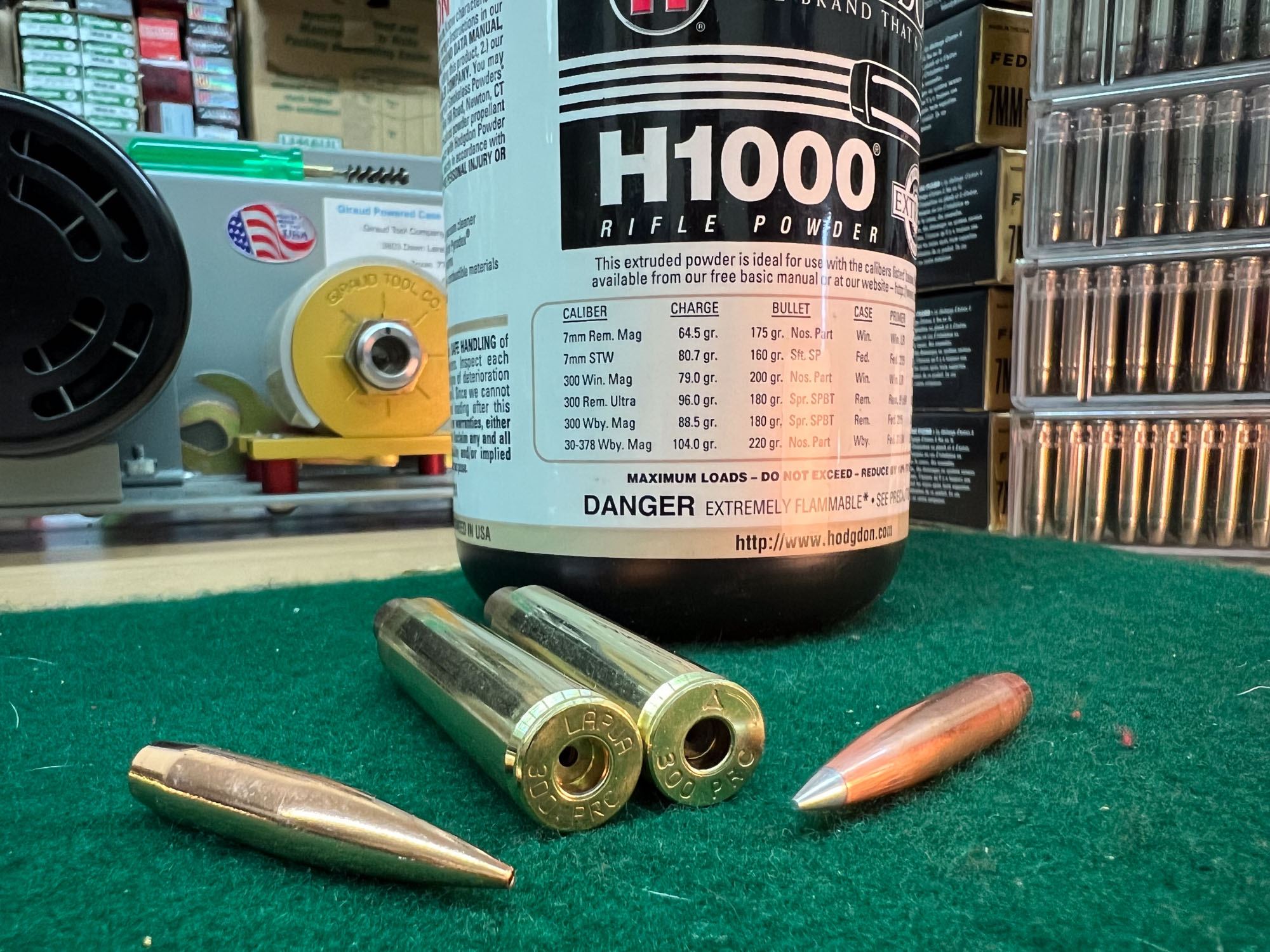
John B. Snow
Handloading the 300 PRC vs 300 Win Mag
For shooters who like to handload, the 300 PRC has an edge over the 300 Win Mag. As anyone who has handloaded belted magnum cartridges knows, that belt creates a couple issues. One is that it can be more difficult to properly size the entire case and, secondly, you get fewer firings from brass with belts before they fail. The 300 PRC is more forgiving that way.
When I develop loads for competition or hunting I use Hornady’s 4DOF app, as well as Applied Ballistics. (I like the redundancy.) One small advantage the 300 PRC has here is that Hornady has more radar-generated drag profiles of their best match bullets in their 4DOF app. Some of those bullets can be shot in the 300 Win Mag, but the most interesting bullets—the 225-grain ELD-M, 230-grain A-Tip, and 250-grain A-Tip—are really only suited for the 300 PRC.
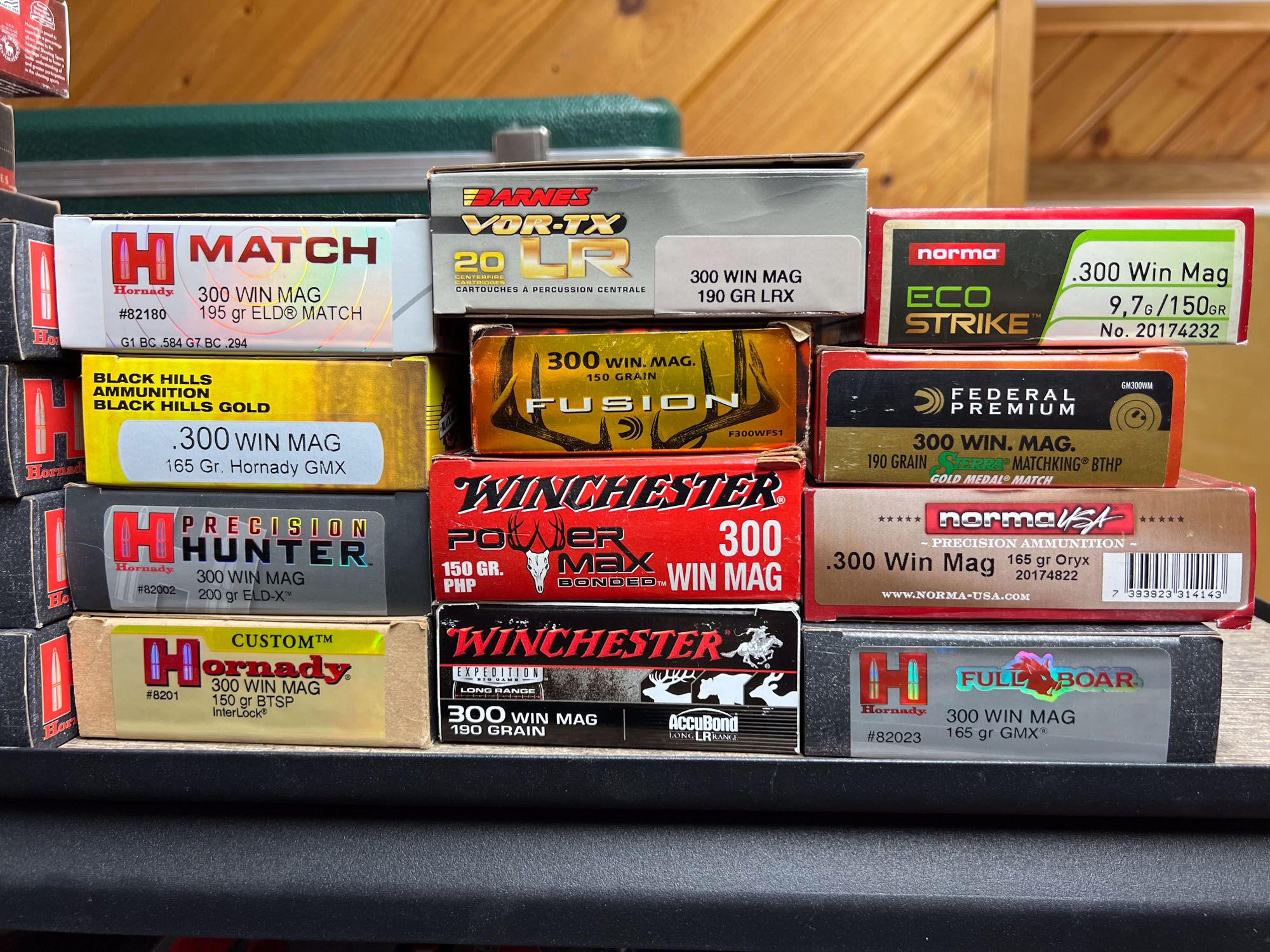
John B. Snow
300 Win Mag Pros and Cons
Pros
- Proven track record on big game around the world
- Excellent selection of factory ammunition and bullet weights
- Generally accurate at long-range hunting distances
Cons
- Not able to take advantage of today’s best bullets without modifications to chamber and twist rate
- Not as capable at extreme ranges as the 300 PRC
300 PRC Pros and Cons
Pros
- Designed to deliver maximum accuracy for extreme long-range shooting
- Optimized to work with the best long-range bullets
- Extremely capable on big game
Cons
- Selection and availability of factory ammunition is relatively limited compared to 300 Win Mag
Frequently Asked Questions
No. They are completely different cartridges. Other than the fact that they both shoot .308-caliber bullets, there is nothing interchangeable between the two rounds.
In specialized military rifles with custom chambers that run high-pressure ammunition, the 300 Win Mag is effective to about 1,600 yards. For the casual recreational shooter, the 300 Win Mag will work well on targets to 1,300 yards, assuming the rifle is capable of 1 MOA accuracy.
The 300 PRC is effective out past 2000 yards. Battlefield data has shown that the round is capable of a 30-percent hit rate on a man-sized targets at 2,000 meters (2,187 yards), which is outstanding for a rifle.
The maximum overall length of a 300 PRC is 3.700 inches per SAMMI specs.
Both cartridges shoot .308-caliber bullets, and there are many bullets that both rounds can shoot, especially those weighing between 190 and 212 grains. In general, the 300 Win Mag uses bullets from 150 to 190 grains, while the 300 PRC shoots bullets from 180 to 250 grains.
The recoil on a 300 PRC is similar to that of a 300 Win Mag Both are stout and can be difficult to manage in lighter hunting rifles, especially on rifles that don’t have a muzzle brake. But in heavy sniper-type rifles, the recoil is not bad.
On a high-end precision rifle where you need peak accuracy, the effective life of a 300 PRC is roughly 1,600 rounds. On a typical hunting rifle, it is unlikely that it will be shot enough to wear out a barrel, but you can expect a barrel life of at least 1,000 rounds under normal shooting conditions.
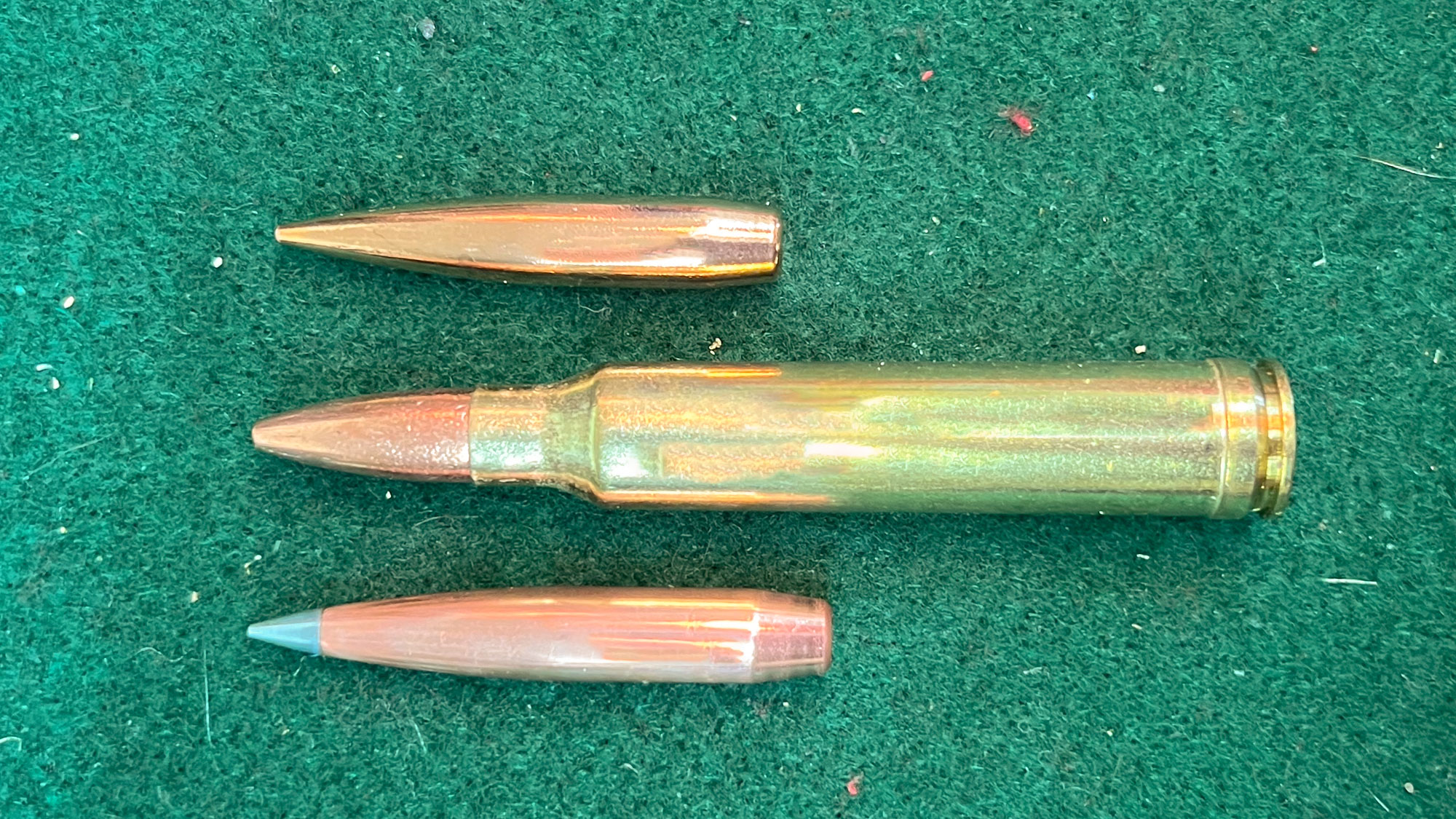
John B. Snow
Final Thoughts on the 300 PRC vs 300 Win Mag
For the dedicated big-game hunter who isn’t into long-range shooting, I’d have a hard time arguing against the 300 Win Mag. It is a great round with a great heritage. And if you’re the kind of shooter who is willing to make some modifications to your rifle, you can get a custom chamber and twist rate that makes up for many of the shortcomings in the 300 Win Mag’s old-school design.
From the technical standpoint, the 300 PRC is the superior cartridge for extreme long-range work, and if you want to rock the latest and greatest it is the way to go. It has a better selection of match bullets for ELR shooting and brings more to the party for the handloader.
Ultimately, there’s no right or wrong answer here. Maybe it is as simple as old versus new. For the traditionalist, the 300 Win Mag is still the king of the .30-caliber magnums. For the tech-savvy hunter and shooter, there’s no denying that the 300 PRC, and other cartridges built upon the same design philosophy, is the future.

